This is an Eigenbau Kamera, which is German for “home made camera”. This unique, one of a kind of camera shoots 24mm x 24mm square images on regular 35mm film. It uses a Kodak branded Compur-Rapid shutter from a Kodak Retina IIa, and has an unknown focal length lens screwed in place of the Ektar lens which would have originally come on that Kodak shutter. The camera has quite a number of innovative features like a focusing helix controlled by a large knob on the camera’s top plate, along with a top plate shutter release, and exposure counter. The camera is covered in a soft snake-skin like leather and is surprisingly well made, suggesting it could have possibly been a prototype perhaps by a company who never got off the ground.
Film Type: 135 (35mm) 24mm x 24mm Square Exposures
Lens: Unknown focal length (shape and size suggest a telephoto focal length)
Focus: 0.4 meters to Infinity
Viewfinder: Scale Focus
Shutter: Kodak Compur-Rapid Leaf
Speeds: B, 1 – 1/500 seconds
Exposure Meter: None
Battery: None
Flash Mount: None
Weight: Unknown
Manual: None
The Voncabbage Collection
 In the fall of 2021, I had the opportunity to visit the Voncabbage Collection, one of the largest private collections of cameras in the world. The owner of this collection wishes to remain anonymous, but granted me full access to thousands of rare and unusual cameras, many of which were prototypes, one offs, or rare cameras that many collectors would go their whole lives and never see.
In the fall of 2021, I had the opportunity to visit the Voncabbage Collection, one of the largest private collections of cameras in the world. The owner of this collection wishes to remain anonymous, but granted me full access to thousands of rare and unusual cameras, many of which were prototypes, one offs, or rare cameras that many collectors would go their whole lives and never see.
Although I was able to handle and photograph any camera I wanted, when faced with literally thousands of cameras, there’s only so much time you can spend with each one. The owner let me photograph anything I wanted, but there wasn’t enough time to shoot film in any of them.
This year, I will be sharing some of the photos of cameras I took in a series of Voncabbage Collection reviews, along with whatever I could find about each one.. These reviews will be shorter, and sometimes missing things that I was unable to discover in the short time I handled them, but I’ll still do my best to find whatever I can!
What I Know
Another weird one from the Voncabbage Collection. Back in June, I reviewed the Eigenbau Kamera Einer, a strange home made camera that shot 12mm x 17mm images on regular 35mm film. Like that camera, this second camera also shoots images smaller than typical 35mm full frame and is also surprisingly well made.
Unlike the first Eigenbau camera however, this one comes with a handwritten letter in German, by someone named Leanore Thieleman which gives a bit of provenance to the camera’s origins and history.
A loose translation of the letter is as follows:
I received the “homemade camera” as a gift from a Mr. Johannes (“Hans”) Leuschke, last residence (until about 1952) in Dresden, Eisenacher Strasse, born about 1895.
His first profession was as a cab driver (horse-drawn carriage) for the last Saxon king, then chief driver (automobile) for the factory manager of the Pentagon company in Dresden, where he worked — and tinkered — until his death.
He was a perfect photographer — beginning with building cameras through to the finished positive; all technical work in his small laboratory.
Mr. Leuschke had no offspring; the only son fell in the second world war.
I am pleased that an example of his work is in a good collector’s hands and [illegible] is preserved for posterity.
I will also part with a plate camera that I inherited from my grandfather.
He, the first to own it, was called Marten Lindner, born 1881, most recently (until his death in 1945) residing at 01796 Nauendorf-Saxon, Switzerland, in the house where I now live.
He studied gardening and landscaping, earning the title “Royal Saxon Horticulture Director.” At the end of the previous century he worked in Buehl in Baden as a fruit-growing specialist — hence, he purchased the camera for professional purposes. Several photos that he took with said camera are in my possession and could at least partially be transferred.
By the way – the best thing to do is to negotiate everything here in the beautiful Saxon Switzerland! I would enjoy greeting you as a guest. Until then, Mr. Keil, my loyal helper, will take care of everything.
With friendly greetings,
Leanore Thieleman
Ms. Thieleman’s letter suggests this camera was built by a man named Johannes “Hans” Leuschke who lived in Dresden. Leuschke was a photographer and tinkerer who liked to build his own cameras, suggesting that perhaps more than one of these exists. That he lived in Dresden and liked to build cameras makes sense as both before and shortly after the war, Dresden was the camera making capital of the world, attracting the world’s finest precision mechanics.
The exact purpose and manufacture date of this camera is unknown. The letter suggests that Leuschke died around 1952, which would mean this camera was made before then. The uncoated optics of the unlabeled lens suggest something from before the war, or perhaps it was made with parts from before the war.
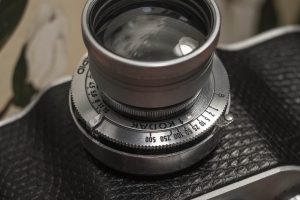
Externally, the camera is very well made, with the most interesting characteristic, the large focus knob on the top plate of the camera. It’s engravings look very professional, which could mean this was taken from another camera. As is the case of most of these home made cameras, parts from a variety of other sources are often used.
The Kodak branded Compur-Rapid shutter possibly came from a Retina, but upon looking at all Compur shutter Retinas, I could not find one that matched the unique Kodak plate which also has aperture f/stops on it. All other Compur-Rapid Retinas have the word “Kodak” separate from the f/stops. The size and top 1/500 speed suggest this wasn’t a medium format shutter, but rather one intended for a 35mm camera.
Edit 11/2/2022: Within hours of posting this review, keen eyed reader u/Oldico correctly identified the shutter from a Kodak Retina IIa Type 150 built between 1939 and 1941. I really thought I had looked at every variant of the Retina to find a matching shutter, but I somehow missed this one. Thank you Mr. Reddit reader for figuring this out!
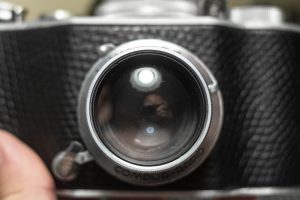
The lens is very peculiar as it has no external markings of any kind to indicate focal length or maximum aperture. The shutter’s diaphragm opens to f/3.5, but that doesn’t necessarily mean the lens supports an entrance pupil that large. Although I do not recognize the lens, it has the appearance of some type of kine lens, likely taken from another camera.
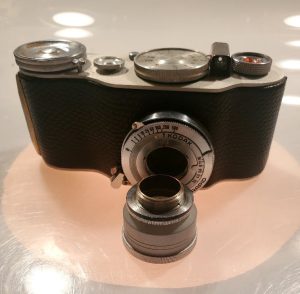
Whatever the lens is, it screws directly into the threads of the Compur-Rapid shutter which would have originally had a 5cm f/3.5 Kodak Ektar lens. The shape and size of the lens suggest it has a longer focal length, which could also suggest that Mr. Leuschke might have built this camera for a specific purpose.
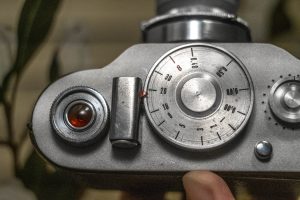
Up top, the camera is very interesting. On the left is the rewind knob with a red bubble level in the center. The presence of this bubble level suggests that the intended purpose for this camera required some level of precision, perhaps for taking landscapes where the horizon was present. Strangely, most cameras with bubble levels have a waist level finder, which this camera does not.
Next to the rewind knob is the straight through optical viewfinder which offers a no frills approximation of what will be captured on film. Contradicting my theory that the lens is a telephoto design, the viewfinder looks to me like any ordinary 50mm viewfinder. Whether this was just a parts bin viewfinder that the owner would have just used to approximate their composition is unclear however.
Without a doubt, the most striking detail on the top plate is the very large focus control knob. Inside of the camera is some type of helix that is used to focus the lens from infinity down to 0.4 meters (1.3 feet). This distance is yet another curiosity as no Kodak branded cameras I am aware of could go this close. Having such a close focus could suggest some type of precision macro photography was done with this camera. Without a rangefinder, or any other type of through the lens focus confirmation, getting in focus images that close would have been extremely difficult.
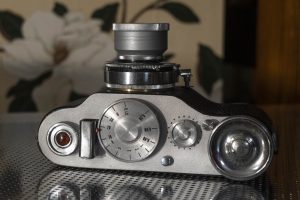
To the right of the focus knob is what appears to be the exposure counter. The knob has a black notch on it’s leading edge which points to one of the 20 black dots engraved into the top plate. Strangely, no numbers appear on the counter, which suggests the original owner probably wasn’t that concerned with knowing how many exposures were made or were left.
The purpose of a small knob below and to the left of the exposure counter is uncertain. The edges of this knob are knurled suggesting it is intended to be rotated, but it does not appear to do anything. Perhaps with film in the camera it is used to help reset the exposure counter.
Above and to the right of the exposure counter is the shutter release, which uses some sort of internal linkage connecting to the Compur-Rapid shutter’s external shutter release up front. Finally, is the large chrome film advance knob, which rotates counterclockwise to advance the film.
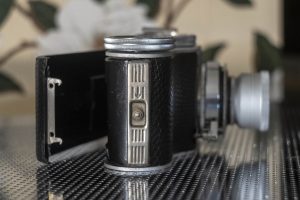
The camera’s right side has the latch for the film compartment. The design of this latch looks familiar, also suggesting it is from some other model, but I cannot place where I might have seen one before. Also note from this image the front to rear length of the camera with it’s lens mounted.
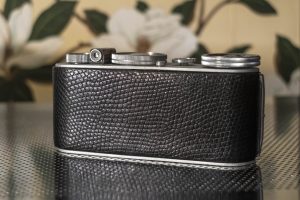
Around back, there isn’t much to see other than a large swath of the very attractive and supple leather reptile body covering. Whether this is real leather or synthetic, I cannot be certain, but it definitely is soft. Also note from the back of the camera, you can see the textured patterns on each of the knobs on top of the camera, and the tiny opening for the optical viewfinder.
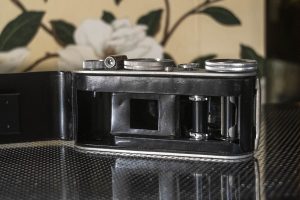
The left hinged door reveals the film compartment. Although I would say that the external finish of the camera is very good, it is in the film compartment where the home made origins of the camera are most easily seen. The sheet metal used for the film gate is wavy and there are plenty of machining marks above and below the film path. It is clear that the inside body of the camera was hand formed, using a combination of off the shelf parts with some custom home made parts. The 24mm x 24mm gate suggests this camera was designed for a special purpose as square format 35mm cameras were very uncommon and usually involved cameras with specialized shutters.
Film transports from left to right onto a fixed and single slotted take up spool. The spool itself and double sprocket shaft look well made, likely from another camera, as does the smooth rectangular film pressure plate on the inside of the door.
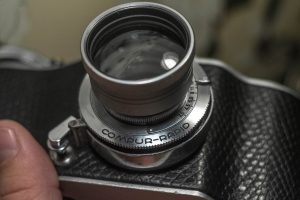
Up front, the Kodak branded Compur-Rapid shutter works as you’d expect. Above the shutter is a manual cocking lever which must be done before pressing the shutter release. The normal shutter release tab is coupled to the linkage connected to the top plate, so there is no need to fire the shutter from the front of the camera. Shutter speeds are selected using a chrome ring around the perimeter of the shutter, and f/stops are selected using the small tab off to the right side of the shutter just like the original Kodak Retina IIa Type 150.
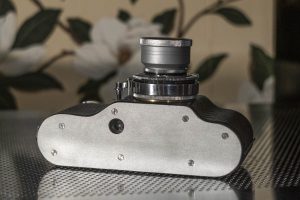
Finally, the bottom of the camera is just a large piece of chromed metal with a 3/8″ tripod socket, further confirming it’s early German roots. Most post war cameras, especially those sold for export would have had a smaller, 1/4″ tripod socket.
And that’s it! Like most “Eigenbau” home made cameras or one off prototypes, getting a complete (or even partial) history of a camera is almost impossible. If I ever had the ability to go back in time, I would most certainly follow cameras like this back to their creator to learn more about who made them and why.
Assuming the details from Leanore Thieleman’s letter are correct, and Johannes Leuschke is the creator of this camera, it is clear he was both very talented, and almost certainly had a very specific purpose for this camera. With an unidentified lens screwed into a Compur-Rapid leaf shutter, with a close focus ability down to 0.4 meters, a bubble level, and such a unique shape, it is hard to not be impressed.
My biggest regret in handling this camera is not having the ability to shoot it as I think it would be a curious experience. At the very least, I would have been able to better confirm the focal length of the lens, and who knows, maybe get some closeups of some bugs or flower petals in a square format!
Related Posts You Might Enjoy
External Links
None

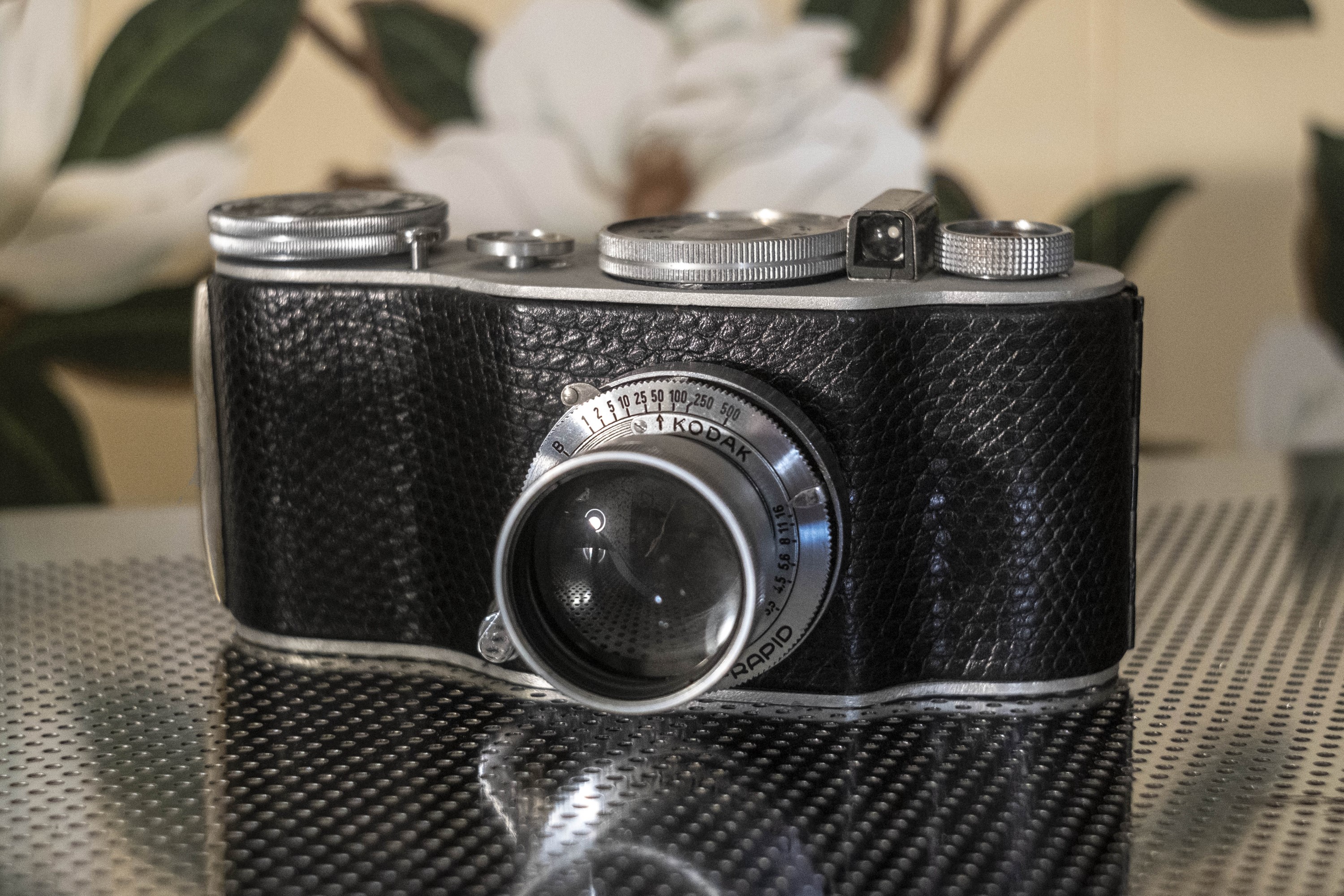

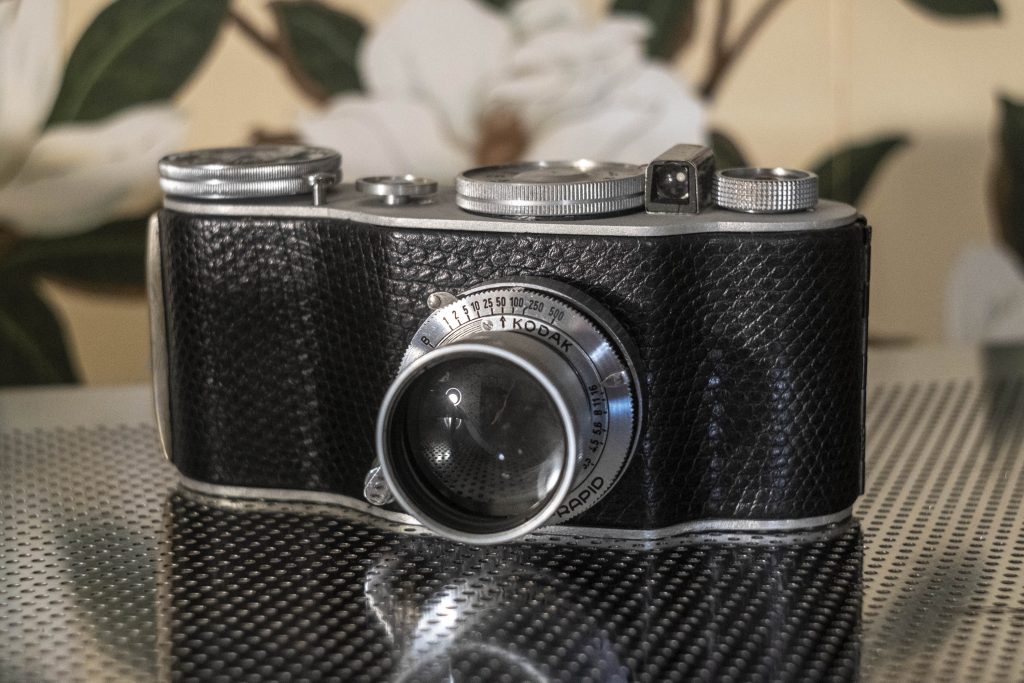
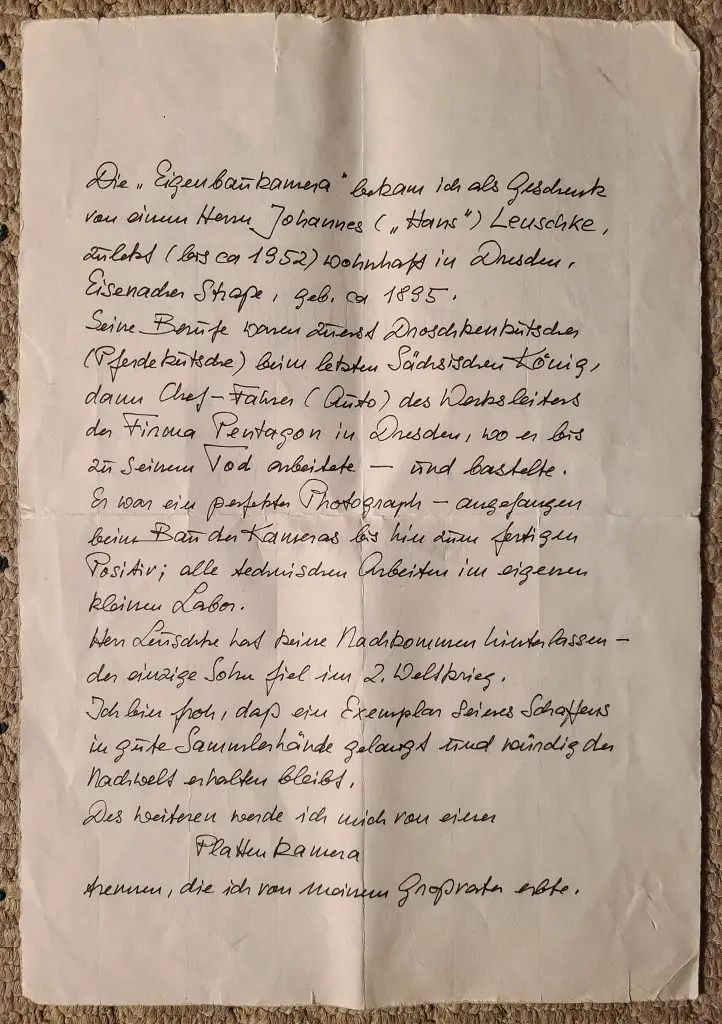
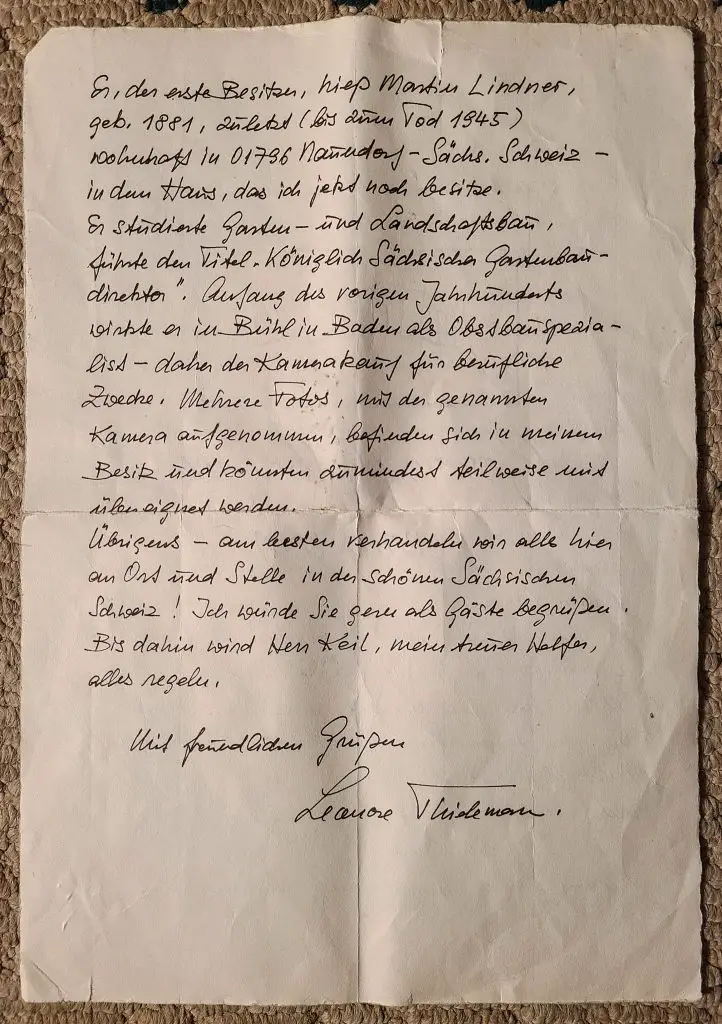
Mike, may I suggest that next visit to Von Cabbage’s Emporium, you take a groundglass with you (available in various precut sizes on The Bay). You can press it against the film plane and, with the shutter set to “B” and using the SWAG method, determine the lens focal length. Next, with your handy pocket ruler, measure the front element diameter. You will then have both focal length and maximum aperture of the lens with pretty good accuracy.